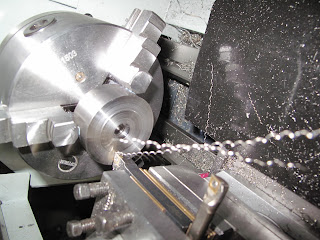This week I managed to tap all 60 holes in the two hubs:
I used the drill press as a way of keeping the thread cutting steady. I operated the belt of the drill by hand since the RPM of the drill would be too high when running on power.
My big fear was that the threadcutter would break, but everything went well. It's only aluminium after all.
As to my fear the tensile strength of the aluminium would not be sufficient, I did a little calculation with a spoke tension of say 100 kg.
Imagine the finished wheel with a spoke in the middle.
The middle spoke would be able to support 100 kg
The two spokes to the left and right would be able to support 100 * cos(360/60) = 99.45 kg each
The two spokes left and right of the previous ones would be able to support 100 * cos(360/60*2) = 97.81 kg each
...
Total load for one half of the wheel would be able to support approximately 2500 kg, so that should not be of any concern.












